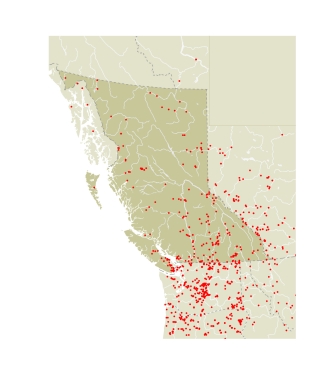Eggs are laid in masses on stinging nettle leaves, and the larvae form an aggregation for feeding. They feed in aggregations and skeletonize the nettle leaves through the first three instars. Some webbing is spun, apparently to provide a secure foothold. Fourth instar larvae begin dispersing and cut, fold, and roll leaves around themselves in the same way as the other nettle-feeders: Satyr Anglewings, West Coast Ladies, and Red Admirals. More than one larva may inhabit a single folded leaf, and larvae of more than one nettle-feeding butterfly species may share a single leaf. Larvae in the fifth and final instar disperse and feed in the open, without rolling leaves (Edwards 1885c; CSG).
Milbert's Tortoiseshells are univoltine in BC but are bivoltine or trivoltine in eastern Canada and Colorado (Layberry et al. 1998; Brown et al. 1957). Adults emerging in July may aestivate until fall and then hibernate for the winter (Guppy 1955). They overwinter successfully near Vernon (Venables 1913), and it is likely that they do so throughout BC. They may also hibernate as both larvae and pupae in Colorado (Ferris and Brown 1981). Shapiro (1974a, 1979) suggests that in California milberti adults hibernate at low elevations on the coast and breed there in the spring, with the resulting offspring migrating to higher elevations. The upward movement appears to occur in the Southern Interior of BC as well, but with no indication of a fall movement back to low elevations. Population densities are usually too low to permit monitoring of elevational movements. Larvae suffer an extremely high rate of parasitism (Edwards 1885c). All of the about 50 Milbert's Tortoiseshell larvae collected on southern Vancouver Island (Guppy 1951), and all but one of about 100 larvae collected at Botanie Valley near Lytton (CSG), were parasitized by tachinid flies.
Stinging nettle (Urtica dioica) is the larval foodplant in BC (Dyar 1904b; Harvey 1908; Jones 1933; Guppy 1951; Atkinson 1978; CSG; FIS) and in most other places. In Colorado, willows and wild sunflowers (Helianthella) are reportedly used in addition to stinging nettle (Brown et al. 1957), which seems improbable.
|
|
